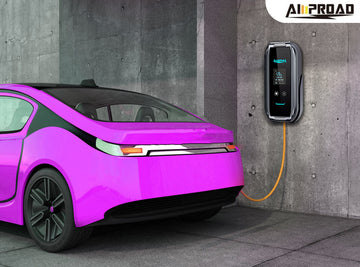
The growing adoption of electric vehicles has sparked discussions about the profitability of EV charging stations. Several factors influence their financial viability, including location, charger type, pricing models, competition, and maintenance costs. Maximizing profitability often involves strategic partnerships, additional services, dynamic pricing, and alternative revenue streams. As EV technology advances, innovations like smart charging, grid integration, wireless charging, and vehicle-to-grid (V2G) systems continue to shape the future of charging infrastructure and its economic potential.
Evaluating the Profitability Equation
As the electric vehicle (EV) market expands, evaluating the profitability equation for EV charging stations becomes crucial. Several factors contribute to the success and economic viability of these charging stations, influencing the decision-making process for businesses and investors.
Location and Accessibility:
The success of an EV charging station is heavily dependent on its location. Stations situated in high-traffic areas, such as shopping centers, business districts, and along major highways, tend to attract more users. Accessibility and visibility play key roles in encouraging EV owners to choose a specific charging station.
Type of Chargers Installed:
The variety of chargers installed at a station is a significant determinant of its profitability. Stations with different charger types, including slow, fast, for example level 2 ev charger, or DC fast chargers, cater to a broader range of EVs with varying charging capabilities. Offering fast charging options is particularly important for attracting users who are looking for quick top-ups during their journeys.
Pricing Models:
The pricing model adopted by a charging station directly impacts its profitability. Common pricing models include charging per kilowatt-hour (kWh), per minute, or subscription-based plans. Each model has its pros and cons. Charging per kWh provides transparency for users, while per-minute models may be more profitable during peak hours. Subscription plans can create customer loyalty and a steady revenue stream.
Competition in the Area:
The level of competition in the vicinity of an EV charging station can affect its profitability. Areas with limited charging infrastructure may provide a competitive advantage. Additionally, collaborations with local businesses, such as restaurants or shopping centers, can attract more users and enhance the overall appeal of a charging station.
Maintenance Costs and Government Incentives:
Maintenance costs are a critical aspect of the profitability equation. Regular maintenance ensures that charging stations remain operational, reliable, and safe. Government incentives and subsidies can significantly impact the financial viability of electric vehicle charging stations. Incentives may include tax credits, grants, or other forms of support that alleviate the financial burden on station operators.
Investors and businesses considering the establishment of EV charging stations need to carefully analyze these factors to create a successful and sustainable venture. Conducting a thorough feasibility study that takes into account the local market dynamics, user behavior, and regulatory landscape is essential. Additionally, staying abreast of technological advancements and industry trends ensures that electric vehicle charging remain competitive and aligned with the evolving needs of the growing EV market. As the EV ecosystem continues to mature, strategically positioned and well-managed charging stations are poised to play a pivotal role in supporting the widespread adoption of electric vehicles.
The Electric Vehicle Revolution
The Electric Vehicle (EV) Revolution is in full swing, marked by the rapid growth of the EV market and a significant increase in EV ownership. As we navigate the 21st century, the shift towards sustainable and eco-friendly transportation is becoming increasingly apparent. Numerous factors contribute to the burgeoning popularity of EVs, including environmental concerns, technological advancements, and changing consumer preferences.
One of the driving forces behind the EV surge is the proactive role of governments worldwide. Governments are implementing policies and incentives to encourage the adoption of electric vehicles. These measures include tax credits, rebates, and subsidies for EV buyers. The aim is to make EVs more affordable and appealing, fostering a transition from traditional internal combustion engine vehicles to cleaner alternatives.
The adoption of electric vehicles is also influenced by the growing awareness of climate change and the need for sustainable practices. Consumers are more inclined to choose environmentally friendly options, contributing to the positive momentum of the EV market. Automakers are responding to this demand by investing heavily in the development of electric vehicles with improved range, performance, and features.
However, for the EV revolution to reach its full potential, a robust and well-developed charging infrastructure is essential. The convenience and accessibility of charging stations play a pivotal role in encouraging EV adoption. Governments, businesses, and private entities are working together to establish an extensive network of EV charging stations, ensuring that EV owners can charge their vehicles conveniently, whether at home, workplaces, or public locations.
The growth of the EV charging infrastructure is not limited to a specific region or country. It's a global phenomenon driven by the collective understanding of the need to reduce dependence on fossil fuels and mitigate the environmental impact of transportation. Governments are investing in charging networks to create a seamless experience for EV owners, eliminating range anxiety and promoting long-distance travel.

The integration of smart technologies in EV charging infrastructure further enhances the user experience. Smart charging stations offer features such as real-time monitoring, payment integration, and connectivity with mobile apps, providing EV owners with greater control and flexibility over their charging sessions.
Strategies for Enhancing Profitability

Maximizing the profitability of electric vehicle (EV) charging stations requires innovative strategies that go beyond the traditional charging model. By adopting a multifaceted approach, charging station operators can enhance revenue streams and create a more compelling user experience.
Strategic Partnerships:
Collaborating with local businesses or public organizations is a strategic move to increase foot traffic and attract more users to the charging station. Partnerships with shopping centers, restaurants, or tourist attractions can create synergies that benefit both parties. Users are more likely to choose ev car charging station that offer additional amenities or services and this's surely good choice for choosing the portable EV charger.
Diversification of Services:
To increase dwell time at charging stations, operators can explore offering additional services. Integrating retail options or food services can transform the charging station into a destination rather than just a pit stop. Providing a comfortable and engaging environment encourages users to spend more time, contributing to increased revenue from both charging and ancillary services.
Dynamic Pricing Models:
Implementing dynamic pricing models allows charging station operators to adjust rates based on demand and time of day. Peak hours or high-demand periods may warrant higher prices, while lower rates during off-peak times can attract cost-conscious users. Dynamic pricing not only optimizes revenue but also helps distribute charging demand more evenly.
Non-Charging Revenue Streams:
Vehicle charging stations can explore alternative revenue streams beyond charging fees. Integrating advertising spaces at the station or partnering with brands for promotional activities can generate additional income. Additionally, anonymized data collected from user interactions and charging patterns can be monetized, providing insights for businesses and urban planners.
Subscription Plans and Loyalty Programs:
Offering subscription plans or loyalty programs can create a sense of brand loyalty among EV users. Subscription models, where users pay a fixed monthly fee for unlimited or discounted charging, incentivize repeat business. Loyalty programs with rewards, such as discounts or exclusive perks, encourage users to choose a particular charging station over competitors.
Technology Integration:
Embracing technological advancements, such as smart charging solutions and mobile apps, enhances user convenience and experience. Providing real-time updates on charging availability, integrating payment systems, and enabling remote monitoring contribute to a seamless and user-friendly charging experience.
By strategically implementing these approaches, charging station operators can not only optimize revenue but also contribute to the growth and sustainability of the EV charging infrastructure. As the EV market continues to expand, innovative and user-centric strategies will be essential for staying competitive and meeting the evolving needs of electric vehicle users.
The Future of EV Charging Stations
The future of electric vehicle (EV) charging stations is poised for significant advancements, driven by evolving technologies that aim to enhance efficiency, sustainability, and user experience.
Smart Charging Stations:
The integration of smart technologies into charging stations is a key development in the future of EV charging. Smart evse charging station leverages data analytics, connectivity, and automation to optimize energy usage, improve charging efficiency, and provide real-time insights. These stations can dynamically adjust charging speeds, synchronize with grid conditions, and offer personalized charging experiences based on user preferences.
Grid Integration:
Grid integration plays a crucial role in the future of EV charging, aligning charging activities with grid capacity and demand. By incorporating advanced grid management systems, charging stations can contribute to grid stability. This bidirectional communication ensures that charging occurs when energy supply is abundant and cost-effective, benefitting both users and the overall energy ecosystem.

Wireless Charging:
Wireless charging technology is gaining momentum as a futuristic solution for EVs. Eliminating the need for physical cables, wireless charging pads or plates transfer energy to the vehicle through electromagnetic fields. This technology simplifies the charging process, enhances user convenience, and reduces wear and tear on physical connectors. As wireless charging infrastructure expands, it could revolutionize EV charging accessibility, particularly in urban environments.
Vehicle-to-Grid (V2G) Systems:
Vehicle-to-Grid (V2G) systems represent a paradigm shift in the relationship between EVs and the energy grid. In V2G systems, electric vehicles can not only draw energy from the grid but also feed excess energy back into the grid when parked. This bidirectional flow allows EVs to function as mobile energy storage units, contributing to grid stability during peak demand periods. V2G technology holds the potential to transform EVs into integral components of a decentralized and resilient energy infrastructure.
Enhanced User Experience:
The future of EV charging stations focuses on delivering an enhanced user experience. Integration with mobile apps, predictive analytics, and real-time communication ensures users have convenient access to charging stations near me, receive personalized recommendations, and stay informed about charging status. These features contribute to a seamless and user-friendly charging journey.
As technological innovation continues to shape the future of EV charging stations, the industry is moving towards greater efficiency, sustainability, and user-centric solutions. The convergence of smart technologies, wireless charging, and V2G systems heralds a future where EV charging is not only ubiquitous but also seamlessly integrated into the broader energy landscape.
Variety of Charging Stations
Today, there are several types of electric vehicle (EV) charging stations designed to meet the diverse needs of EV owners. The main categories include:
|
Charger Type |
Voltage |
Power Output |
Charging Speed |
Use Cases |
|
Level 1 Charger |
120V |
Low |
Slow |
Home Charging, Plug-in Hybrid Electric Vehicles (PHEVs) |
|
Level 2 Charger |
240V |
Moderate |
Moderate |
Home Charging, Public Charging Stations |
|
DC Fast Charger (Level 3) |
400V and above |
High |
Fast |
Quick Top-ups, Highway Charging |
|
Tesla Supercharger |
Varies |
Very High (for Teslas) |
Very Fast |
Long-Distance Travel, Exclusive to Tesla Vehicles |
|
Wireless Charger |
Varies |
Moderate |
Moderate |
Convenience, Reduced Wear on Connectors |
|
Varies |
Varies |
Varies |
Convenient EV Home Charging, Customizable for EV Owners |
|
|
Public Charging Station |
Varies |
Varies |
Varies (Level 2 to DC Fast Chargers) |
Charging on the Go, Public Areas, Shopping Centers |
The variety of charging stations available reflects the evolving infrastructure to support the growing adoption of electric vehicles, providing flexibility and accessibility for EV owners in different scenarios.


